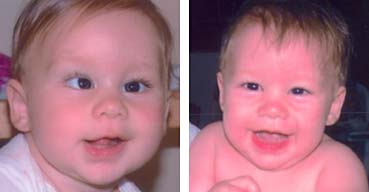
PHOTOS COURTESY DR. MALCOLM ING
Baby "C.F." had crossed eyes before undergoing corrective surgery. The photo at left was taken the day before the operation, the photo at right the day after.
Early fix key
to good eyesOcular misalignment in infants should
be treated within one year, says research
A baby born with crossed eyes should have corrective surgery within a year to achieve depth perception, says a Honolulu pediatric ophthalmologist.
"Prior to this, the existing theory was if you allow eyes to be straightened within the first two years of life, you got pretty good functional results," said Dr. Malcolm Ing, chief of ophthalmology at Kapiolani Medical Center for Women & Children.
That is true in some respects, but not for depth perception, which is more sensitive to the misalignment, he said.
Ing conducted a landmark study that he said sets the timetable back one year, instead of two, for surgical alignment of crossed eyes in infants. Ing's study was reported in Ocular Surgery News and was one of a group of eye studies selected for publication in the Yearbook of Ophthalmology.
He examined 90 children who had congenital esotropia, or misalignment, by 6 months of age and underwent surgery.
He visited practices of five ophthalmologists in the United States and one in Canada, and obtained their permission to independently examine the children for motor alignment and depth perception.
They averaged about 9 1/2 years old, "so they were mature enough to do a sensory test," he said. To avoid bias, he did not look at their clinical history until he finished the examinations.
He said there was some controversy about whether alignment of crossed eyes could wait until a child is 3 or 4, but his study "disproved that dramatically."
It showed that depth perception, or stereopsis, depends on the age that the misalignment appears and the duration of it. "The two are somewhat intertwined."
Crossing of eyes occurred by 2 months of age in 80 of the children studied and by three, four or five months in the other 10.
Surgical alignment was done at 4 to 24 months of age, but most patients were aligned by 1 year. The duration of misalignment ranged from two to 21 months.
His findings show that depth perception is much poorer if the eyes are crossed longer than one year, Ing said.
No patients with more than 18 months of misalignment the first two years of life -- about 25 percent of those studied -- had depth perception, he said.
About 1 percent of newborns have crossed eyes, Ing said. "If they are truly crossed, they don't align." But the appearance of crossing is common in children with flat nasal bridges and eyelids set so they are wide, he said.
The flattening of the nasal bridge and prominence of the lid fold "sort of hides the white," he said. Some Asian children especially look like they have crossed eyes, he said.
That appearance goes away as the nose bridge develops, but "true crossing doesn't go away," he said. "We use six months as the cutoff."
If the child has a preference for one eye, the lazy eye is patched to try and develop it to prepare for surgery, he said. "The patch is a very simple treatment but very effective. It is probably the least expensive method of improving vision that can result in blindness."
A child cannot read with an eye that remains crossed, and will be blind in that eye, he said.
Once the infant is using both eyes to follow a target, although they are still crossed, they can be surgically aligned before operating on the eye muscles, he said.
For the children studied, surgery was done at different ages in their first two years and after different lengths of misalignment, he said.
The study showed 84 percent of the children who had crossed eyes for up to six months and 72 percent who were misaligned up to 12 months achieved depth perception. Only half of those who were misaligned up to 21 months had depth perception.
Ing said depth perception was adversely affected in children whose eyes were misaligned longer than one year or if surgery was done more than one year after the misalignment.
Some children in the study did not show crossing until later in the first six months of their lives, he said.
Ing said he expected those aligned after only six months of misalignment would have a better result than those aligned at 12 months.
That did not occur, indicating there is flexibility within the first 18 months, but the best results are achieved for babies aligned in six months to a year, he said.
"After that, it started to trail off and fell off completely if they were misaligned for 18 months."
About 20 percent to 30 percent of children may need a second surgery if the first one does not achieve complete alignment, Ing said. "They might be aligned and slip out. Sometimes there is vertical misalignment. Other things can come up."
He said a number of children in the study required glasses to stabilize the alignment.
He said he usually sees babies at 3 to 4 months of age. "We really have an alert group of pediatricians and family doctors in our community. They don't sit on it. ... It's one of the keys to successful, early detection and early referral."
